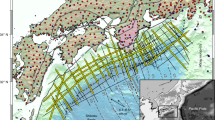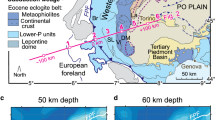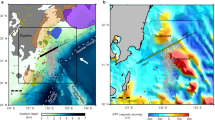Abstract
Constraints on the potential size and recurrence time of strong subduction-zone earthquakes come from the degree of locking between the down-going and overriding plates, in the period between large earthquakes. In many cases, this interseismic locking degree correlates with slip during large earthquakes1,2,3,4 or is attributed to variations in fluid content at the plate interface5. Here we use geodetic and seismological data to explore the links between pore-fluid pressure and locking patterns at the subduction interface ruptured during the magnitude 8.8 Chile earthquake in 2010. High-resolution three-dimensional seismic tomography reveals variations in the ratio of seismic P- to S-wave velocities (Vp/Vs) along the length of the subduction-zone interface. High Vp/Vs domains, interpreted as zones of elevated pore-fluid pressure, correlate spatially with parts of the plate interface that are poorly locked and slip aseismically. In contrast, low Vp/Vs domains, interpreted as zones of lower pore-fluid pressure, correlate with locked parts of the plate interface, where unstable slip and earthquakes occur. Variations in pore-fluid pressure are caused by the subduction and dehydration of a hydrothermally altered oceanic fracture zone. We conclude that variations in pore-fluid pressure at the plate interface control the degree of interseismic locking and therefore the slip distribution of large earthquake ruptures.
This is a preview of subscription content, access via your institution
Access options
Subscribe to this journal
Receive 12 print issues and online access
$259.00 per year
only $21.58 per issue
Buy this article
- Purchase on Springer Link
- Instant access to full article PDF
Prices may be subject to local taxes which are calculated during checkout




Similar content being viewed by others
References
Chlieh, M., Avouac, J., Sieh, K., Natawidjaja, D. & Galetzka, J. Heterogeneous coupling of the Sumatran megathrust constrained by geodetic and paleogeodetic measurements. J. Geophys. Res. 113, B05305 (2008).
Perfettini, H. et al. Seismic and aseismic slip on the Central Peru megathrust. Nature 465, 78–81 (2010).
Moreno, M., Rosenau, M. & Oncken, O. 2010 Maule earthquake slip correlates with pre-seismic locking of Andean subduction zone. Nature 467, 198–202 (2010).
Loveless, J. P. & Meade, B. Spatial correlation of interseismic coupling and coseismic rupture extent of the 2011 M w = 9.0 Tohoku-oki earthquake. Geophys. Res. Lett. 38, L17306 (2011).
Audet, P. & Schwartz, S. Hydrologic control of forearc strength and seismicity in the Costa Rican subduction zone. Nature Geosci. 6, 852–855 (2013).
Perfettini, H. & Ampuero, J. P. Dynamics of a velocity strengthening fault region: Implications for slow earthquakes and postseismic slip. J. Geophys. Res. 113, B09411 (2008).
Oleskevich, D. A., Hyndman, R. D. & Wang, K. The updip and downdip limits to great subduction earthquakes: Thermal and structural models of Cascadia, south Alaska, SW Japan, and Chile. J. Geophys. Res. 104, 14965–14991 (1999).
Song, T. R. A. & Simons, M. Large trench-parallel gravity variations predict seismogenic behavior in subduction zones. Science 301, 630–633 (2003).
Bürgmann, R. et al. Interseismic coupling and asperity distribution along the Kamchatka subduction zone. J. Geophys. Res. 110, 1–17 (2005).
Audet, P., Bostock, M., Christensen, N. & Peacock, S. Seismic evidence for overpressured subducted oceanic crust and megathrust fault sealing. Nature 457, 76–78 (2009).
Miller, S. A. Properties of large ruptures and the dynamical influence of fluids on earthquakes and faulting. J. Geophys. Res. 107, 2182 (2002).
Moore, J. C. & Saffer, D. Updip limit of the seismogenic zone beneath the accretionary prism of southwest Japan: An effect of diagenetic to low-grade metamorphic processes and increasing effective stress. Geology 29, 183–186 (2001).
Kodaira, S. et al. High pore fluid pressure may cause silent slip in the Nankai Trough. Science 304, 1295–1298 (2004).
Tsuji, T., Tokuyama, H., Costa Pisani, P. & Moore, G. Effective stress and pore pressure in the Nankai accretionary prism off the Muroto Peninsula, southwestern Japan. J. Geophys. Res. 113, B11401 (2008).
Audet, P., Bostock, M. G., Boyarko, D. C., Brudzinski, M. R. & Allen, R. M. Slab morphology in the Cascadia fore arc and its relation to episodic tremor and slip. J. Geophys. Res. 115, B00A16 (2010).
Groß, K., Micksch, U. & Group, T. R. The reflection seismic survey of project TIPTEQ-the inventory of the Chilean subduction zone at 38.2° S. Geophys. J. Int. 172, 565–571 (2007).
Haberland, C., Rietbrock, A., Lange, D., Bataille, K. & Dahm, T. Structure of the seismogenic zone of the southcentral Chilean margin revealed by local earthquake traveltime tomograph. J. Geophys. Res. 114, B01317 (2009).
Moreno, M. et al. Toward understanding tectonic control on the M w 8.8 2010 Maule Chile earthquake. Earth Planet. Sci. Lett. 321–322, 152–165 (2012).
Bedford, J. et al. A high-resolution, time-variable afterslip model for the 2010 Maule M w = 8.8, Chile megathrust earthquake. Earth Planet. Sci. Lett. 383, 26–36 (2013).
Contreras-Reyes, E., Grevemeyer, I., Flueh, E. & Reichert, C. Upper lithospheric structure of the subduction zone offshore of the southern Arauco Peninsula, Chile, at ∼35° S. J. Geophys. Res. 113, B07303 (2008).
Christensen, N. Poisson’s ratio and crustal seismology. J. Geophys. Res. 101, 3139–3156 (1996).
Willner, A., Glodny, J., Gerya, T., Godoy, E. & Massonne, H-J. A counterclockwise ptt path of high-pressure/low-temperature rocks from the coastal cordillera accretionary complex of south-central Chile: Constraints for the earliest stage of subduction mass flow. Lithos 75, 283–310 (2004).
Eberhart-Phillips, D., Han, D. H. & Zoback, M. D. Empirical relationships among seismic velocity, effective pressure, porosity, and clay content in sandstone. Geophysics 54, 82–89 (1989).
Yan, F. & Han, D. SEG Technical Program Expanded Abstracts Modeling of effective pressure effect on porous reservoir rocks. 2025–2029 (Society of Exploration Geophysicists, (2009).
Christensen, N. Chapter 32: Pore pressure, seismic velocities, and crustal structure. Geol. Soc. Am. Memoir. 172, 783–798 (1989).
Lamb, S. Shear stresses on megathrusts: Implications for mountain building behind subduction zones. J. Geophys. Res. 111, B07401 (2006).
Scholz, C. H. Earthquakes and friction laws. Nature 391, 37–42 (1998).
Ranero, C., Phipps Morgan, J., McIntosh, K. & Reichert, C. Bending-related faulting and mantle serpentinization at the Middle America trench. Nature 425, 367–373 (2003).
Bachmann, R. et al. Exposed plate interface in the European Alps reveals fabric styles and gradients related to an ancient seismogenic coupling zone. J. Geophys. Res. 114, B05402 (2009).
Sleep, N. H. Ductile creep, compaction, and rate and state dependent friction within major fault zones. J. Geophys. Res. 100, 13065–13080 (1995).
Acknowledgements
We thank A. Nur for advice regarding the stress calculation. We also thank M. Rosenau, J. Bedford, E. Contreras-Reyes and H. Sone for comments and discussions on the manuscript. We are grateful to H. Perfettini for his review and comments, which helped to improve the manuscript. This work was supported in part by the MARISCOS MO/2310/1-1 project of the German Research Foundation (DFG). The seismic data were acquired with instruments of the Geophysical Instrument Pool (GIPP).
Author information
Authors and Affiliations
Contributions
C.H. and A.R. constructed the 3D tomography and conducted the synthetic resolution tests. O.O. developed the conceptual idea of the study. M.M carried out the locking and pore-fluid pressure calculations. O.H. was involved in the investigation of effective stress, pore-fluid pressure and mechanical interpretations. S.A. contributed to the petrological interpretation, conceptual model, pore-fluid calculations and figure design. All authors discussed the results and implications and shared in writing the manuscript.
Corresponding author
Ethics declarations
Competing interests
The authors declare no competing financial interests.
Supplementary information
Supplementary Information
Supplementary Information (PDF 2689 kb)
Rights and permissions
About this article
Cite this article
Moreno, M., Haberland, C., Oncken, O. et al. Locking of the Chile subduction zone controlled by fluid pressure before the 2010 earthquake. Nature Geosci 7, 292–296 (2014). https://doi.org/10.1038/ngeo2102
Received:
Accepted:
Published:
Issue Date:
DOI: https://doi.org/10.1038/ngeo2102
This article is cited by
-
The influence of mantle hydration and flexure on slab seismicity in the southern Central Andes
Communications Earth & Environment (2023)
-
Seismicity distribution in the Tonankai and Nankai seismogenic zones and its spatiotemporal relationship with interplate coupling and slow earthquakes
Progress in Earth and Planetary Science (2022)
-
Megathrust reflectivity reveals the updip limit of the 2014 Iquique earthquake rupture
Nature Communications (2022)
-
Aseismic slip and recent ruptures of persistent asperities along the Alaska-Aleutian subduction zone
Nature Communications (2022)
-
Seismic rate variations prior to the 2010 Maule, Chile MW 8.8 giant megathrust earthquake
Scientific Reports (2021)



